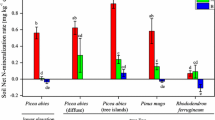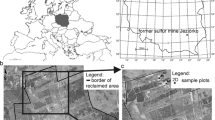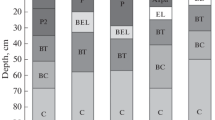Summary
In the “Solling-Projekt” (IBP) of the “Deutsche Forschungsgemeinschaft” the decomposition of different qualities of leaves in acid soil (Solling) and in lime soil (Göttinger Wald) was studied under various conditions (October 1973–October 1974).
Plastic rings were used as litter bags in the following way: on the bottom side they were covered with gauze of different mesh sizes (50, 1120, or 6000 μm), after they had been filled with leaves the upper sides were closed by a gauze with an equal mesh size (about 1200 μm). The effects of abiotic factors, microorganisms, meso- and macrofauna, phytophagous-excrements, and leaf-powder are shown by the following results:
-
1.
In lime soil the decomposition was higher than in acid soil.
-
2.
The decomposition effected by microorganisms alone was less than that by microorganisms and mesofauna; this, however, was less than the one by microorganisms, meso- and macrofauna.
-
3.
Shade-leaves were decomposed more than sun-leaves and these more than leaves 1 year old.
-
4.
In acid soil phytophagous-excrements effected a very high decomposition while in lime soil an effect was not to be found.
-
5.
Leaf-powder effected a very high decomposition of sun-leaves and leaves 1 year old in both forests, of shade-leaves, however, in acid soil only.
-
6.
In the Solling (acid soil) and in the Göttinger Wald (lime soil) shadeleaves from the Solling as well as from the Göttinger Wald were decomposed equally.
-
7.
In the Solling the decomposition of leaves with phytophagous-excrements or leaf-powder compared with the decomposition in the Göttinger Wald without phytophagous-excrements or leaf-powder was nearly the same if mesofauna was allowed to enter, but the decomposition was highly significantly smaller if macrofauna was allowed to enter, which was rather scarce.
-
8.
In the winter half-year the decomposition was smaller than in the summer half-year. The decomposition in the winter- and the summer half-year together (October 1973–April 1974 and April 1974–October 1974) was considerably higher than the decomposition of that litter which had been exposed for a whole year without interruption.
-
9.
Some of the leaves sprayed with Toluol were partly destroyed more than those sprayed with Naphthalin.
Similar content being viewed by others
Literatur
Anderson, J.M.: The breakdown and decomposition of sweet chestnut (Castanea sativa Mill.) and beech (Fagus silvatica L.) leaf litter in two deciduous woodland soils. I. Breakdown, leaching and decomposition. Oecologia (Berl.) 12, 251–274 (1973)
Bocock, K.L., Gilbert, O.J.W.: The disappearance of leaf litter under different woodland conditions. Plant and Soil IX, no. 2, 179–185 (1957)
van der Drift, J., Witkamp, M.: The significance of the breakdown of oak litter by Enoicyla pusilla Burm. Arch. Neerland. Zool. 13, 486–492 (1960)
Dunger, W.: Untersuchungen über Laubstreuzersetzung durch Collembolen. Zool. Jahrb. Syst. 84, 75–98 (1956)
Dunger, W.: Über die Zersetzung der Laubstreu durch die Boden-Makrofauna im Auenwald. Zool. Jahrb. Syst 86, 139–180 (1958)
Edwards, C.A., Heath, G.W.: The role of soil animals in breakdown of leaf material. In: Soil organisms (J. Doeksen, J. van der Drift, eds.), pp. 76–84. Amsterdam: North-Holland 1963
Edwards, C.A., Reichle, D.E., Crossley, D.A., Jr.: The role of soil invertebrates in turnover of organic matter and nutrients. Ecol. Studies 1, 147–172 (1972)
Ellenberg, H.: Integrated experimental ecology, Berlin-Heidelberg-New York: Springer 1971
Funke, W.: Energieumsatz von Tierpopulationen in Land-Ökosystemen. Verh. Deut. Zool. Ges. Helgoland 1971, 65. Jahresversammlung, S. 95–106, Jena: Fischer 1972
Funke, W.: Rolle der Tiere in Wald-Ökosystemen des Solling. In: Ökosystemforschung (H. Ellenberg, Hrsg.), S. 143–164. Berlin-Heidelberg-New York: Springer 1973
Gere, G.: Über einige Faktoren des Streuabbaus. In: Soil organisms (J. Doeksen, J. van der Drift, eds.), pp. 67–75. Amsterdam: North-Holland 1963
Gerlach, A., Krause, A., Meisel, K., Speidel, B., Trautmann, W.: Vegetationsuntersuchungen im Solling. Schriftenr. Vegetationsk. 5, 75–78 (1970)
Heath, G.W., Arnold, M.K.: Studies in leaf-litter breakdown. II. Breakdown rate of “sun” and “shade” leaves. Pedobiol. 6, 238–243 (1966)
Heath, G.W., Arnold, M.K., Edwards, C.A.: Studies in leaf-litter breakdown. I. Breakdown rates of leaves of different species. Pedobiol. 6, 1–12 (1966)
Heath, G.W., Edwards, C.A., Arnold, M.K.: Some methods for assessing the activity of soil animals in the breakdown of leaves. Pedobiol. 4, 80–87 (1964)
King, H.C., Heath, G.W.: The chemical analysis of small samples of leaf material and the relationship between the disappearance and composition of leaves. Pedobiol. 7, 192–197 (1967)
Kurcheva, G.F.: The role of invertebrates in the decomposition of the oak leaf fall [in Russ.]. Pocvovedenie 4, 16–23 (1960)
Kurcheva, G.F.: Wirbellose Tiere als Faktor der Zersetzung von Waldstreu. Pedobiol. 4, 7–30 (1964)
Kurcheva, G.F.: The influence of the increased abundance and the moistening on the rate of the oak litter decomposition [in Russ.]. Pedobiol. 7, 228–238 (1967)
Mudra, A.: Statistische Methoden für landwirtschaftliche Versuche. Berlin: Parey 1958
Runge, F.: die Pflanzengesellschaften Deutschlands unter besonderer Berücksichtigung der Pflanzengesellschaften der Bundesrepublik Deutschland. Münster: Aschendorff 1969
Satchell, J.E., Lowe, D.G.: Selection of leaf litter by Lumbricus terrestris. In: Progress in soil biology (O. Graff, J.E. Satchell, eds.), pp. 102–120. Amsterdam: Braunschweig 1967
Winter, K.: Zum Energieumsatz phytophager Insekten im Buchenwald. Untersuchungen an Lepidopterenpopulationen. Dissertation, Göttingen (1972)
Witkamp, M.: Decomposition of leaf litter in relation to environment microflora, and microbial respiration. Ecology 47, 194–201 (1966)
Witkamp, M., Crossley, D.A., Jr.: The role of arthropods and microflora in breakdown of white oak litter. Pedobiol. 6, 293–303 (1966)
Witkamp, M., Olson, J.S.: Breakdown of confined and nonconfined oak litter. Oikos 14, 138–147 (1963)
Wittich, W.: Untersuchungen über den Verlauf der Streuzersetzung auf einem Boden mit Mullzustand. II. Forstarchiv 19, 1–18 (1943)
Wittich, W.: Untersuchungen über den Verlauf der Streuzersetzung auf einem Boden mit starker Regenwurmtätigkeit. Schriftenr. Forstl.Fak. Göttingen 9, 1–33 (1953)
Zachariae, G.: Spuren tierischer Tätigkeit im Boden des Buchenwaldes. Forstwiss. Forsch., H. 20 (1965)
Zlotin, R.I.: Die massenhafte Vermehrung des grünen Eichenwicklers als Stimulator der biologischen Kreislaufes in Eichenwäldern. In: Struktur und funktions-bio-geo-zönotische Rolle der lebenden Tierbevölkerung des Bodens [in Russ.]. Moskau: MOIP 1967
Zlotin, R.I.: Invertebrate animals as a factor of the biological turnover. IV. Colloq. Intern. de la Fauna du Sol. Dijon, 1970. Paris: Institut nationale de la recherche agronomique 1971
Zlotin, R.I., Khodashova, K.S.: Die Rolle der Lebewesen im biologischen Kreislauf der Waldsteppenökosysteme [in Russ.]. Moskau: Nauka 1974
Author information
Authors and Affiliations
Additional information
Ergebnisse des “Solling-Projekts” der DFG (IBP), Mitteilung Nr. 198
Herrn Prof. Dr. W. Funke danken wir für Themenstellung, fördernde Diskussionen und Betreuung, Herrn Prof. Dr. G. Kobabe, Göttingen, für großzügige Hilfen bei der statistischen Bearbeitung der Ergebnisse
Rights and permissions
About this article
Cite this article
Herlitzius, R., Herlitzius, H. Streuabbau in Laubwäldern. Oecologia 30, 147–171 (1977). https://doi.org/10.1007/BF00345418
Received:
Issue Date:
DOI: https://doi.org/10.1007/BF00345418




